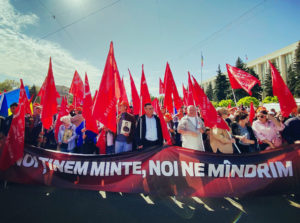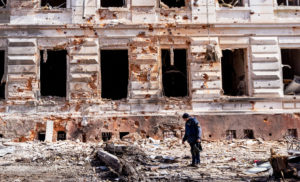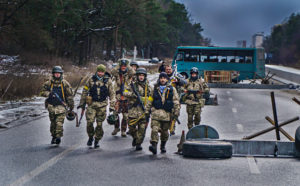Tiraspol, Transnistria
The road is quiet, and the day is hot outside the administrative HQ of the Operational Group of Russian forces in Tiraspol. A few peeling murals of past triumphs can be seen over the wall. A notice promises that “Wartime service in the Russian army is a real man’s activity”.
A weathered-looking soldier with the Russian tricolour on his arm stands guard at a run-down depot across the road. He stares at the sky with a cigarette in his mouth, rifle hanging limp at his side. A modern digital camouflage pattern cover stretches awkwardly across his wide bowl-shaped helmet, which belongs to a different era.
A rusty gate swings open. Another middle-aged man with a paunch pushes a wheelbarrow onto the road. He chirpily asks how I am doing and, discovering I am a foreigner — a military-aged Westerner at that — laughs and nonchalantly waves me away.
These men are a snapshot of the rogue, disconnected Russian forces of Transnistria. Mostly locally recruited, the 14th Soviet Guards Army, fewer than 2,000 men, were reportedly put on full alert on April 26. If such an order has been issued, it is being carried out with a lethargy reflective of this breakaway republic as a whole.
While the armed forces offer regular pay, reliable housing, and social security, young men, who ought to carry the military vitality of this society, resist its call. They do not flock to join the army.
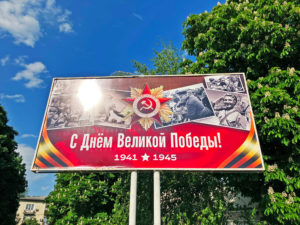
Instead, they, like the young women here, want out. Average salaries on this side of the Dniester River are around 200-300 US Dollars a month. Travelling through the country, it becomes apparent — despite the existence of a few cafés with Instagram-friendly decor — that Transnistria’s raison d’être is to soothe the anxiety of nostalgic pensioners.
Tiraspol looks as if it is still part of the USSR. Lenin’s face, grave in concrete, is all over the place. But despite the aesthetics, Marxism-Leninism is not so easy to find. Due to geopolitical quirks, socially and economically, the country has little in common with the old USSR.
Though reliable statistics are hard to obtain, due to official secrecy and the fact that most residents also hold Moldovan, Russian, or Ukrainian passports, the total number of pensioners was estimated to be as high as 135,000 in 2014. This out of a shrinking overall population of 300,000 — 500,000 (down from 706,000 in 1990). Moscow pays every pensioner here a monthly stipend of 10-15 US dollars. As such, the aged are firmly pro-Russian.
The legal grey zone established in Transnistria after it gained de facto independence from Moldova in the 1990-92 War, suited, and continues to benefit, semi-legal commercial activity. The omnipresent Sheriff Corporation, the undisputed winner of the Nineties in the region, is more East India Company than Soviet command economics. With Russian backing, Sheriff effectively runs the state, holding significant control over local politics, media, sport, and with a monopoly on most other major industries.
Between Sheriff and the pensioners, Transnistria exists in a kind of suspended animation. The majority of the middle-aged and the elderly own their apartments, and utility costs are relatively low due to Russian gas subsidies. Often, they are more materially comfortable than their equivalents over the border in Moldova. Thus, with the help of a few hammers and sickles, Victory Day parades, and some cognitive dissonance, the majority, squinting hard, can convince themselves that the stability, purpose, and structure of the good old days never really went away.
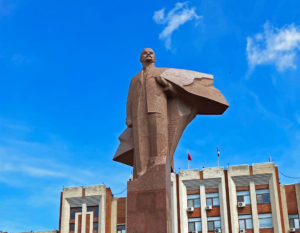
Transnistria, then, is a gerontocracy. Along Tiraspol’s main avenue, 25th October Street, elderly males wearing military decorations and the Saint George’s Ribbon (a symbol of Russian allegiance now banned in Moldova) reprimand young strangers for sitting on the steps of the monument to Catherine the Great. I watch a lone mother push a single pram around playgrounds designed for crowds of children. Maria, a Sheriff supermarket worker in her mid-30s, coming home from a trip to Chisinau, lists the family members who have left, rarely to return. These include her former husband and children, along with her sisters and aunts. “I’m the only one left” she says.
Transnistria isn’t alone in Eastern Europe experiencing such rapid demographic decline. But, unlike elsewhere, there is no youth migration from rural villages; almost all leave to go abroad. Tiraspol simply does not have the pull of Moscow, Warsaw, Kiev, or even Minsk for those in the provinces.
Plugging the demographic gaps are pro-Russian Ukrainians who arrived after 2014. They make up a fair share of Tiraspol’s service workers and are naturally comforted by the semiotics. Something of the old Soviet bunker mindset survives in them. I spoke to several café workers the morning after a military recruitment centre was reportedly attacked with a Molotov cocktail, and they claimed to have heard nothing of it. Nor, for that matter, had they heard of the rocket-propelled-grenade attack on the Ministry of State Security building that was reported in the West, the destruction of the radio broadcast tower at Mayak, or the shots reportedly fired from Ukrainian territory near the huge ammunition dump at Cobasna.
Transnistria’s official name, The Pridnestrovian Moldavian Republic, acknowledges it is part of a larger country. But Transnistria’s relationship with Moldova is not a particularly bellicose one any more. The old and the middle-aged — and those with one child families — do not like fighting. The border crossing is surprisingly painless and un-militarized, even during the current tensions. The football team, “Sheriff” Tiraspol (who beat Real Madrid in the Champions League last year), play in the Moldovan league. Citizens come and go on a daily basis and Russian forces are said to change into civilian clothing and fly in and out of Chisinau airport, having long lost their transit privileges through Ukraine.
The recent attacks in Tiraspol have seen false flag accusations thrown at Moscow’s door. This could well be the case; Russian military doctrine places a great deal of importance on the sowing of confusion – see the much cited and not often fully understood work of General Gerasimov. It should be noted, though, that official Ukrainian advisors such as Oleksiy Arestovych and Anton Gerashenko have been openly calling for the seizure of Transnistria. Such rhetoric — and the inevitable counter-rhetoric — could lead to escalation without the planned intention of either side, especially if it were to gain traction among the populace.
However, while Transnistria is culturally pro-Russian, there is little observable aggression towards those on the other side of this Slavic feud, or those in power in Chisinau. Most are friendly, open to outsiders, and are genuinely proud of the state’s multi-ethnic make-up: only 29.1% of the population were recorded as ethnically Russian in the 2014 census. Observers place the total strength of the Transnistrian military at less than 10,000 active soldiers, with little in the way of operational heavy weaponry, aircraft, or armoured vehicles. An image recently released by the Transnistrian Ministry of Defence, widely mocked on Twitter due to the vintage character of the weapons, vehicles and uniforms, would appear to be an accurate reflection of the combat readiness of their armed forces.
Neither Tiraspol nor Chisinau want the war to spread across the border from Ukraine. In Maia Sandu’s recent speech to the European Parliament, she was reported to have “demanded” Russian Forces withdraw from Moldovan territory. In reality, this “demand” was somewhat more of an audience pleasing request. The bulk of the speech reaffirmed Moldovan peacefulness and constitutional neutrality. If the war that continues to burn in Ukraine does spread across the border to Transnistria and Moldova, it will not have been driven there by the mentality and ambitions of either of these aged, fatigued societies.
Disclaimer
Some of the posts we share are controversial and we do not necessarily agree with them in the whole extend. Sometimes we agree with the content or part of it but we do not agree with the narration or language. Nevertheless we find them somehow interesting, valuable and/or informative or we share them, because we strongly believe in freedom of speech, free press and journalism. We strongly encourage you to have a critical approach to all the content, do your own research and analysis to build your own opinion.
We would be glad to have your feedback.
Source: UnHerd Read the original article here: https://unherd.com

